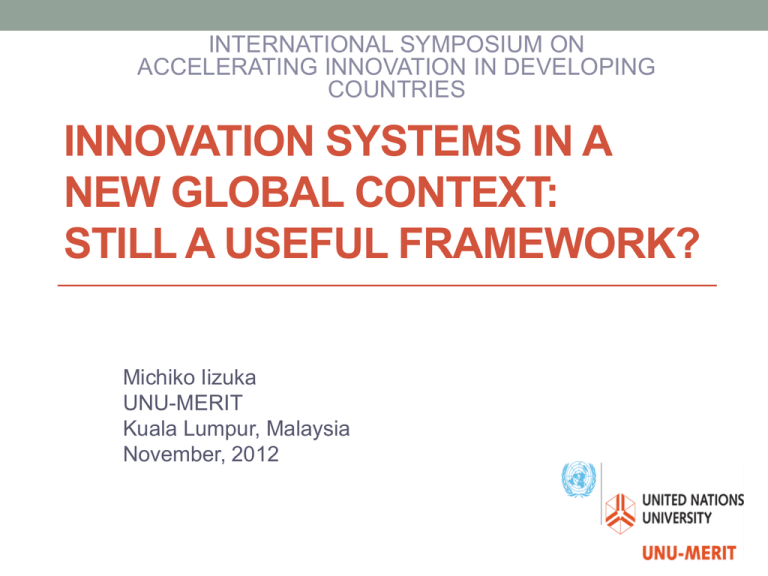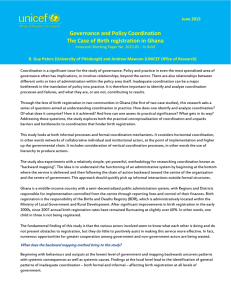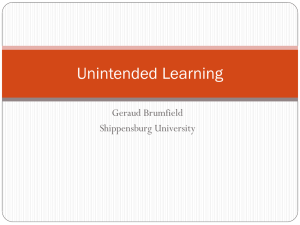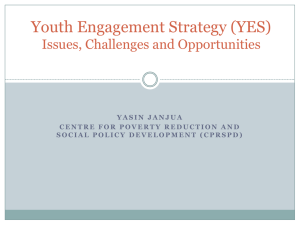Innovation systems in a new global context: still a useful - unu
advertisement

INTERNATIONAL SYMPOSIUM ON ACCELERATING INNOVATION IN DEVELOPING COUNTRIES INNOVATION SYSTEMS IN A NEW GLOBAL CONTEXT: STILL A USEFUL FRAMEWORK? Michiko Iizuka UNU-MERIT Kuala Lumpur, Malaysia November, 2012 2 What is innovation? “Implementation of a new or significantly improved product (good/service) or process, a new marketing methods, or a new organization methods in business practices, workplace organization or external relations.” ‘Implementation’ means introduced to the market (OECD/Eurostat 2005) 3 What is innovation system? • Act as a ‘focusing device’ for policy via • Identifying actors and firm as driving force • Understanding interactions for knowledge flow • Differentiate actors from contextual conditions • Institutional settings • Culture, religion • Provided holistic vision of barriers/functions of innovative behavior (policy dimension) • Policy aimed to accelerate innovation activities of firms 4 Innovation System Innovation system (UNIDO, 2007) 5 Knowledge flow & Innovation system • Importance of informal knowledge flow • Factors that influence the degree and speed of knowledge flow • Social capital • Trust • Culture • History 6 Changing conditions for innovation process • New challenges • Globalization of knowledge diffusion & flow • New types of innovation in changing world • User Innovation • Social Innovation • Public sector innovation • Innovation for inclusive development 7 Globalization of knowledge diffusion & flow • Increasing interaction through trade, investment (FDI) and people (migration) created knowledge flow at global level • Development of ICT (information communication technology) and provision of IPR(intellectual property right) also support flow of knowledge However, • Mixed results for developing countries because • Indigenous capability is required for adaptation • Absorptive capacity • Proper institutional set up/ intermediaries is required for appropriation of knowledge in equitable manner (benefit sharing mechanism) • Local capacity needs to be strengthened • http://www.youtube.com/watch?v=k_8-YDA9Dc4&feature=related 8 Story about commercializing indigenous knowledge -Need an idea - belong to different segment of society -Linking knowledge - Tacit/Traditional/Local & Generic/Scientific/Global -Intermediary linking institution -NGO, local government, Local academic institution, local community -Establishing mechanisms of fair distribution of benefits Globalization-opens opportunity but need local capacity 9 New types of innovation User Innovation Social Innovation Public sector innovation Innovation for inclusive development 10 User innovation • Creation or alteration of goods or services by user with an aim to increase the benefit of its use • Consumers and users are the driving force for innovation • User innovation may not directly contribute to the Market contrary to the official definition provided by the Olso manual • Often very difficult to be noticed(though information being collected) • Diffusion process varies (user-producer, user becoming entrepreneurs, users sharing the knowledge among themselves) 11 Social Innovation • Innovation that served society and enhance social capacity to act or creates social impact in meeting social goals: ‘creating solutions’ • Not directly connected to market • Driving force is not always firm but some firms do • Non pecuniary-measurement difficult: happiness, quality of life, desirable innovation? 12 Public sector innovation • Improve efficiency and productivity of public sector in their delivery of services to the citizens • Recently focused due to financial crisis in developed countries • The innovation is not directly introduced to market but to users • Needs to establish criteria for measurement 13 Innovation for inclusive development • Focus on innovation in informal settings that allows marginalized population to take part in formal economy and benefit from it. • Not connected to market—if not partially. • Community/ marginalized group centered 14 Features of innovation for inclusive development Informal setting - Idea often comes from community (demand side) due to lack of services or goods to solve problems ex. Mobile phone banking and • Multistakeholder knowledge diffusion and innovation • Unconventional actors such as NGO, informal media, local corner shops • Collaborative learning 15 Summary of emerging changes 1 • Aim of innovation • Productivity of firm Solution for society • Driving force/main actor of innovation • Firm Self organizing users and consumers/community • Actors • Conventional formal informal Non-conventional/ 16 Summary of emerging changes 2 Knowledge flow • Interactions at multiple dimensions • Global –local, formal-informal, Economic-Social, User-Producer Type of solutions • Technology fix to Holistic solution • Complex and out of box 17 Conclusion • Innovation system need to expanded to accommodate • Solve non pecuniary problem under less understood environment • Informal • Traditional • Community of practice • Involving unconventional actors and different types of interactions











